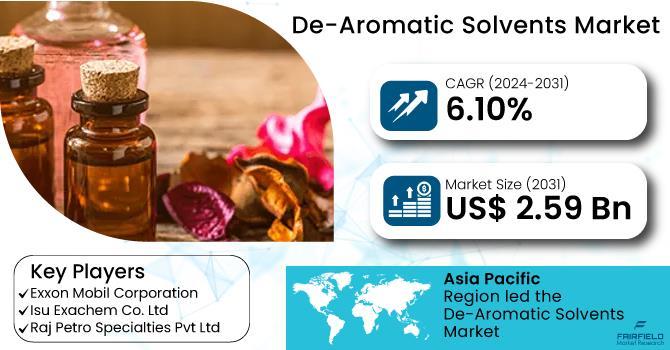De-aromatic Solvents Market

The global de-aromatic solvents market is set to experience substantial growth, with projections indicating an increase from $1.7 billion in 2024 to $2.59 billion by 2031. This expansion is expected to occur at a compound annual growth rate (CAGR) of 6.10% over the forecast period of 2024-2031.
For More Industry Insight: https://www.fairfieldmarketresearch.com/report/de-aromaticsolvents-market
Market Dynamics and Growth Drivers
The de-aromatic solvents market is gaining momentum, primarily fueled by increasing demand from key sectors such as paints, coatings, automotive, and industrial applications. A significant driver of this growth is the shift towards more sustainable and environmentally friendly products, propelled by stringent environmental regulations. These regulations are pushing industries to adopt de-aromatic solvents, which offer lower volatile organic compound (VOC) emissions compared to their aromatic counterparts.
In addition to regulatory pressures, the market is also supported by the rising preference for bio-based solvents and the expansion into emerging markets. Technological advancements in solvent production are enhancing efficiency and reducing costs, further driving market growth.
Challenges and Opportunities
Despite its positive outlook, the de-aromatic solvents market faces challenges including crude oil price volatility and raw material availability. Fluctuations in crude oil prices directly impact production costs, which can affect profitability and consumer demand. Additionally, supply chain disruptions related to raw materials can constrain production and increase costs.
However, opportunities abound in the form of bio-based solvents and emerging markets. Biobased solvents, derived from renewable resources, are becoming increasingly popular due to their environmental benefits. Emerging economies in regions such as Asia Pacific, South
America, and Africa are presenting new growth opportunities as they undergo rapid industrialization and urbanization.
Regulatory Landscape Impact
The de-aromatic solvents market is heavily influenced by environmental regulations. Stringent emission standards and VOC restrictions are driving the adoption of low-aromatic or dearomatic solvents. Compliance with these regulations is not only a market driver but also a catalyst for innovation in solvent formulations.
Regulatory requirements related to solvent handling and storage have led to increased investments in safety infrastructure and the development of safer formulations. While these regulations present operational challenges, they also create opportunities for companies that can meet compliance standards and offer innovative solutions.
Key Growth Determinants
1. Demand from Paints and Coatings
The paints and coatings industry is a major consumer of de-aromatic solvents. The growth of the construction industry, including residential and commercial projects, is driving demand for paints and coatings. Additionally, the automotive industry’s focus on eco-friendly finishes and vehicle refinishing is contributing to solvent consumption.
2. Environmental Concerns and Regulations
The global focus on reducing environmental impact has led to increased demand for low-VOC products, including de-aromatic solvents. Government-imposed emission standards are pushing industries towards these greener alternatives, driving market growth.
3. Expansion in Automotive and Industrial Sectors
The automotive industry's growth, particularly in developing economies, is fueling demand for de-aromatic solvents. The expansion of manufacturing and industrial activities, including electronics and metalworking, also contributes to market demand.
Market Segmentation
1. Low Flash Point Segment
Low flash point de-aromatic solvents are predominantly used in industrial cleaning applications due to their quick evaporation properties. These solvents are essential in parts cleaning, metal degreasing, and equipment maintenance across various industries
2. Medium Flash Point Segment
Medium flash point solvents are extensively used in paints, coatings, and inks. They are crucial for achieving desired film properties and are also versatile for industrial cleaning tasks.
3. Type 1 and Type 2 Solvents
Type 1 solvents, with their low boiling points, are ideal for quick-drying applications in industrial coatings and automotive refinishes. Type 2 solvents offer a balance of evaporation rate and solvency power, making them suitable for a range of coating formulations and industrial cleaning processes.
4. Paints, Coatings, and Inks
Architectural coatings represent the largest segment within this category, driven by the demand for low-VOC coatings. Industrial coatings and inks for printing applications also constitute significant segments.
5. Industrial Cleaning
The metalworking segment is a major consumer of de-aromatic solvents for cleaning and degreasing metal parts, while general industrial cleaning encompasses the use of these solvents for equipment maintenance and facility cleaning.
Regional Analysis
The Asia Pacific region is the dominant market for de-aromatic solvents, driven by rapid industrialization, urbanization, and economic growth in countries such as China, India, and South Korea. The region’s stringent environmental regulations and the growing automotive and construction sectors are contributing to the market’s expansion.
Competitive Landscape
The de-aromatic solvents market features a mix of large petrochemical companies and smaller specialized manufacturers. Key players include Exxon Mobil Corporation, Shell Plc, Idemitsu Kosan Co., Ltd., and Neste Oyj, among others. The competitive landscape is characterized by moderate intensity, with differentiation based on product quality, price, and environmental performance. Industry consolidation through mergers and acquisitions is a potential trend as companies seek to expand their product portfolios and geographic reach.
